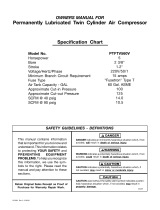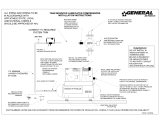
RISKOFELECTRICALSHOCK. IMPROPER
ELECTRICAL GROUNDING CAN RESULT IN
ELECTRICAL SHOCK. WIRING FOR THE PRES-
SURE SWITCH SHOULD BE DONE BY A LI-
CENSED ELECTRICIAN INACCORDANCE WITH
NATIONAL AND LOCAL CODES AND ORDI-
NANCES.
Install the compressor as close to the main power supply
as possible. This practice will avoid using long lengths of
electrical widng for the power supply which can cause
power loss to the motor. When connecting wires, make
sure that :
1. The amperage rating ofthe electrical box isadequate.
Refer to the Specification Chart in the Outfit Parts
Bulletin for your compressor.
2. The supply line has the same electdcal characteris-
tics (voltage, cycle, phase) as the motor.
Widng must be such that full motor nameplate voltage
plus or minus 10% is available at the motor terminals
during starting. Refer to local codes for recommended
wire sizes for correct wire size and maximum wire run;
undersize wire causes high amp draw and overheating to
the motor.
Electrical wiring must be located away from hot
surfaces such as manifold assembly, compres-
sor outlet tubes, beads, or cylinders.
OPERATING PROCEDURES
1. Before attaching air hose or acoessodes, make sure pressor is ready for use.
the OFF/AUTO lever is set to "OFF" and the air
regulator or globe valve is closed.
2. Attach hose and accessories.
6. Always operate the air compressor in well-ventilated
areas; free ofgasoline orothersolvent vapors. Do not
operate the compressor near the spray area.
TOO MUCH AIR PRESSURE CREATES A HAZ-
ARDOUS RISK OF BURSTING. CAREFULLY
FOU.OW STEPS 3 AND 5 EACH TIME THE
COMPRESSOR IS USED.
Compressed air from the outfit may contain
water condensation. Do not spray until-
tered air at an item that could be damaged.
Some air operated tools or devices may
require filtered air. Read the instructions
for the air tool or device.
3. Check the manufacturer's maximum pressure rating
for air tools and accossodes. The regulator outlet
pressure must never exceed the maximum pressure
rating. If your compressor is not supplied with a
regulator with gauge, install one before using acces-
sories.
4. Turn the OFF/AUTO leverto"AUTO" and allowtank
pressure to build. Motor will stopwhen tank pressure
reaches =cut-out" pressure.
5. Openthe regulatorbytuming it clockwise. Adjustthe
regulator to the correct pressure setting. Your com-
When you are finished:
7, Setthe"OFFIAUTO"leverto=OFF ".
8. Turn the regulator counterclockwise and set the
outlet pressure to zero.
9. Removethe airtool or accessory.
10. Open the regulator and allow the air to slowly bleed
from the tank. Close the regulator when tank pres-
sure is approximately 20 psi.
11. Drain waterfrem airtank.
WATER WILL CONDENSE IN THE AIR TANK.
IF NOT DRAINED, WATER WILL CORRODE
AND WEAKEN THE AIR TANK CAUSING A
RISK OF AIR TANK RUPTURE.
With tank pressure at approximately 20 psi, open the
drain cock or drain valve.
NOTE:
If drain cock valve is plugged, release all air
pressure. The valve can then be removed,
cleaned, then reinstalled.
12. After the water has been drained, close the drain
cock or drain valve. The air compressor can nowbe
stored.
9

















